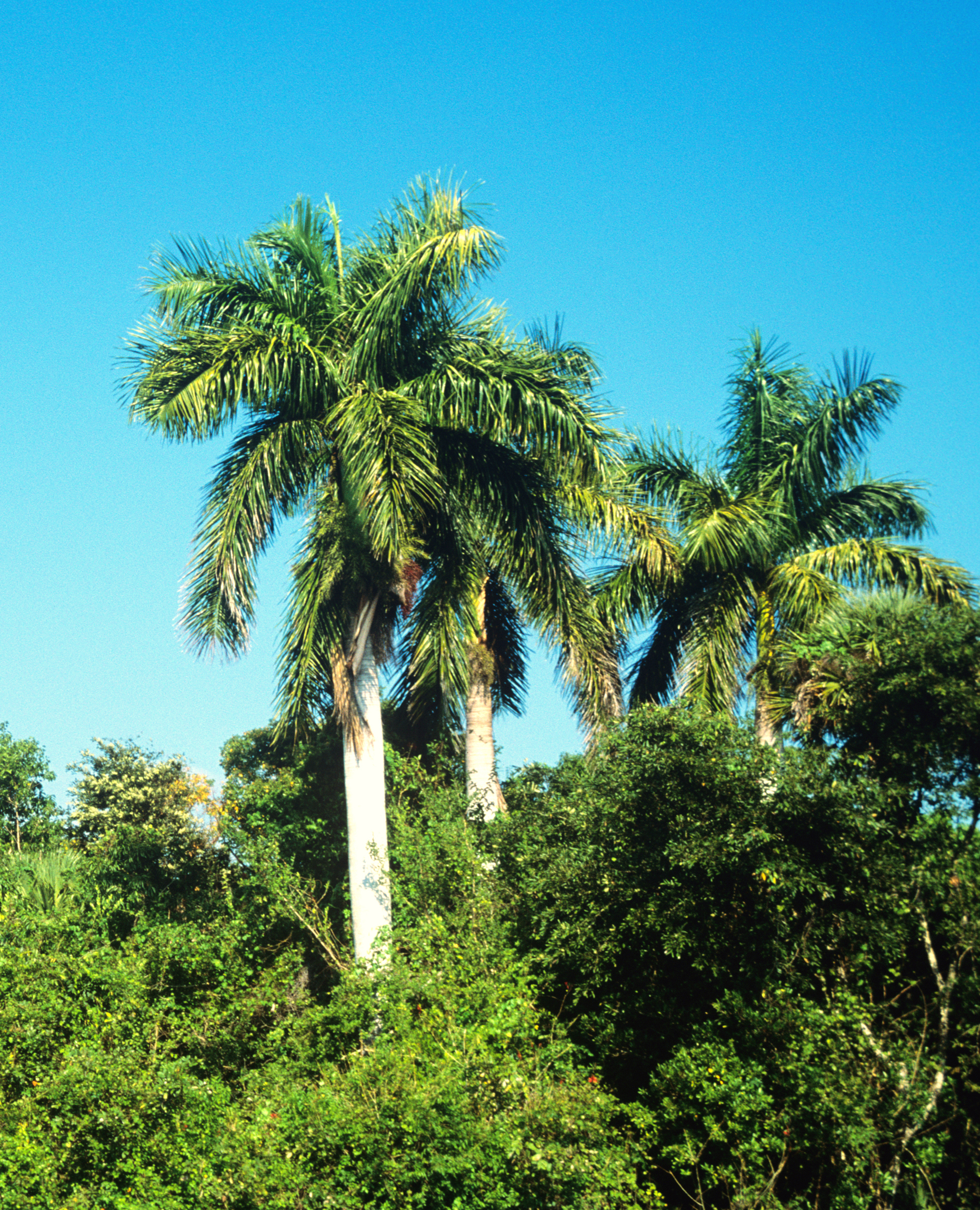- Roystonea
taxobox
name = "Roystonea"
image_caption = "Roystonea regia" atCollier-Seminole State Park , Florida
regnum =Plantae
unranked_divisio =Angiosperms
unranked_classis =Monocots
unranked_ordo =Commelinids
ordo =Arecales
familia =Arecaceae
genus = "Roystonea"
genus_authority = O.F.CookO.F. Cook, Science, ser. 2, 12:479. 1900. Type:"R. regia" (Kunth)]
subdivision_ranks = Species
subdivision = See text|"Roystonea" (Royal Palm) is a
genus of 10species ofmonoecious palms, native to tropical regions ofFlorida , theCaribbean , and the adjacent coasts of Central andSouth America . Named forRoy Stone , aU.S. Army engineer , the genus contains some of the most recognizable and commonly cultivated palms ("R. regia") in tropical and subtropical regions.Description
"Roystonea" species are single-stemmed
tree s, average in height to among the world's tallest. Growing from 10-30 m tall, the trunks are white, or nearly so, often bulging either at the base or the central portion, depending on the species. The leaves are pinnate, 3-7 m long with numerous (about 100) pinnae up to 1 m long and 2-4 cm broad; the leaves also have a distinctive green basal sheath (crownshaft ) extending 2-5 m down the trunk. These plants have the ability to easily release their leaves in strong winds, a supposed adaption serving to prevent toppling duringhurricanes .Inflorescences occur beneath the crownshaft, emerging from a narrow, horn-shapedbract . Theflowers on the branchedpanicles are usually white,unisexual , and contain both sexes. Thefruit is an oblong or globosedrupe 1-2 cm long and deep purple when ripe.Riffle, Robert L. and Craft, Paul (2003) "An Encyclopedia of Cultivated Palms". Portland: Timber Press. (Page 441) ISBN-10: 0881925586 / ISBN-13: 978-0881925586] Some species so closely resemble one another that scientific differentiation is by inflorescence detail; flower size, color, etc.;Species
*"Roystonea altissima " (Mill.) H.E.Moore
*"Roystonea borinquena " O.F.Cook (syn. "R. hispaniolana") - Hispaniola or Puerto Rico Royal Palm
*"Roystonea dunlapiana " P.H.Allen
*"Roystonea lenis" León
*"Roystonea maisiana" (L.H.Bailey) Zona
*"Roystonea oleracea" (Jacq.) O.F.Cook (syn. "R. venezuelana") - Trinidad or Venezuela Royal Palm
*"Roystonea princeps" (Becc.) Burret - Jamaican Royal Palm
*"Roystonea regia " (Kunth) O.F.Cook (syn. "R. elata, R. floridana") - Florida or Cuban Royal Palm
*"Roystonea stellata" León
*"Roystonea violacea" LeónCultivation and uses
Royal palms are widely planted for decorative purposes throughout their native region, and elsewhere in the
tropics andsubtropics . They are considered by many to be the most beautiful palm in the world.While royal palms are considered a "tropical" palm, they do grow in favored
microclimate s in centralFlorida , e.g. some areas aroundTampa Bay andCape Canaveral . They also will grow - albeit slowly - in favored microclimates in southernCalifornia , southernArizona and the extreme southernTexas barrier island s near theGulf of Mexico . Royals are being increasingly planted on Galveston Island where they do very well and as far north as Houston where south of Interstate-10 you are beginning to see individuals 20-30 feet tall, unthinkable just 15 years ago.Royal palms are rather intolerant of cold weather. The foliage will show cold damage at 31°F (-1°C) and the palm will defoliate at 29°F (-2°C). Royal Palms may be killed by temperatures of 25°F (-4°C). That said, seemingly "dead" Royal Palms may occasionally "return to life" after severe freezes in the low 20°F range (-5 or -6°C), but there is usually a trunk constriction that marks the event.
Royal palms are very fond of water and thrive on supplemental
irrigation . They also do better in a soil with lots ofhumus .Because their native location is in "hurricane alley", royal palms have adapted to the high winds by easily shedding their leaves. This leaves a bare trunk that more likely to survive a severe storm than a trunk with a full set of leaves. The palms quickly renew their foliage after such an event. On the island of
Hispaniola , royal palms are trees favored byPalmchat s for feeding, roosting and nesting.The name "Royal Palm" is widely used in Florida for the name of streets, real estate developments, and the village of Royal Palm Beach.
References
reflist
* [http://www.kew.org/wcsp/qsearch.do?plantName=Roystonea&page=quickSearch Kew Palms Checklist: "Roystonea"]
* [http://www.efloras.org/florataxon.aspx?flora_id=1&taxon_id=128826 Flora of North America: "Roystonea"]
Wikimedia Foundation. 2010.
